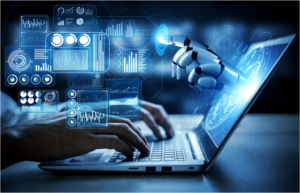Image: Stock Photos by Dreamstime.com
In today’s digital age, where cyber threats are becoming increasingly sophisticated, the need for robust cybersecurity measures has never been more crucial. As organizations and individuals alike face a constant barrage of cyber attacks, technological advancements have introduced a powerful new ally in the fight against these threats: artificial intelligence (AI). In this blog article, we will explore the role of AI in enhancing cybersecurity, and how it is revolutionizing the landscape of digital defense.
Understanding AI and Cybersecurity:
Before delving into the ways AI is enhancing cybersecurity, let’s briefly touch upon what AI is. AI refers to the simulation of human intelligence processes by machines, enabling them to learn, reason, and make decisions on their own. This technology has made significant strides in various fields, including cybersecurity.
1. Threat Detection and Prevention:
AI algorithms analyze vast amounts of data from network traffic, user behavior, and historical attack patterns to detect and mitigate threats in real-time. Traditional rule-based systems often struggle to keep up with rapidly evolving cyber attacks, but AI-powered systems have the capacity to detect anomalies and identify intricate patterns that might go unnoticed otherwise. By continuously monitoring and adapting to new threats, AI helps in proactively preventing attacks before they can cause significant damage.
2. Incident Response and Remediation:
In the event of an attack, AI plays a crucial role in facilitating swift incident response and remediation. AI-powered systems can autonomously investigate security incidents, correlate data from multiple sources, and offer actionable insights. These systems save valuable time and resources by identifying compromised systems and providing guidance on the appropriate remediation steps. As a result, organizations can quickly contain and minimize the impact of a cyber attack.
3. User Authentication and Access Management:
Passwords and traditional authentication methods have long been considered vulnerable to exploitation. AI-based authentication systems can use behavioral biometrics, facial recognition, and voice recognition to authenticate users more accurately. By analyzing patterns, AI can distinguish between genuine users and malicious actors, safeguarding access to sensitive information.
4. Threat Intelligence and Data Analysis:
AI’s capacity to process and analyze large sets of data enables it to identify correlations and patterns that humans may overlook. By analyzing past attack strategies and techniques, AI enhances threat intelligence capabilities by providing critical insights to anticipate potential future threats. AI can also help data analysts spot trends and behavioral patterns that indicate ongoing cyber attacks or anomalies in real-time, allowing for proactive defense measures.
5. Advanced Malware Detection:
The rise of sophisticated malware, including zero-day attacks, make it essential for cybersecurity systems to detect and mitigate threats before they cause extensive harm. AI-powered solutions can analyze the behavior of files and applications, identifying malicious patterns and blocking them in real-time, thus preventing malware infections.
Artificial intelligence is reshaping the cybersecurity landscape, empowering organizations and individuals to better defend against the rising tide of cyber threats. Its ability to detect and prevent attacks, facilitate incident response, enhance authentication processes, gather threat intelligence, and detect sophisticated malware showcases its immense potential. As cyber attacks continue to evolve, AI can adapt and learn, making it an invaluable tool in safeguarding our digital world.
However, it’s important to note that while AI brings numerous benefits to cybersecurity, it is not without its limitations. Ensuring ethical use, addressing biases, and careful monitoring of AI systems are critical in maintaining a robust and secure digital environment. By combining human expertise with AI-powered defenses, we can harness the full potential of AI and stay one step ahead of cybercriminals. Together, we can build a safer cyber world for everyone.


